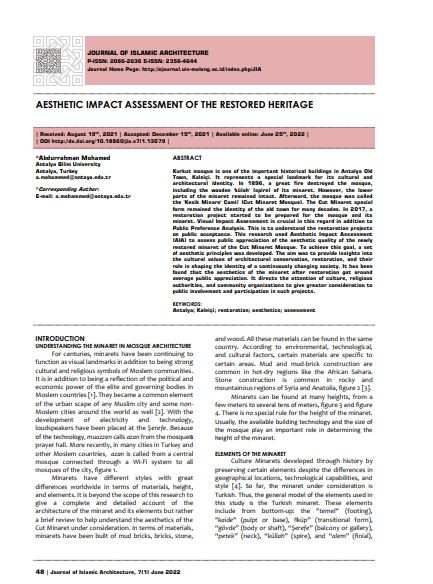
Kurkut mosque is one of the important historical buildings in Antalya Old Town, Kaleiçi. It represents a special landmark for its cultural and architectural identity. In 1896, a great fire destroyed the mosque, including the wooden ‘külah’ (spire) of its minaret. However, the lower parts of the minaret remained intact. Afterward, the mosque was called the ‘Kesik Minare’ Camii’ (Cut Minaret Mosque). The Cut Minaret special form remained the identity of the old town for many decades. In 2017, a restoration project started to be prepared for the mosque and its minaret. Visual Impact Assessment is crucial in this regard in addition to Public Preference Analysis. This is to understand the restoration projects on public acceptance. This research used Aesthetic Impact Assessment (AIA) to assess public appreciation of the aesthetic quality of the newly restored minaret of the Cut Minaret Mosque. To achieve this goal, a set of aesthetic principles was developed. The aim was to provide insights into the cultural values of architectural conservation, restoration, and their role in shaping the identity of a continuously changing society. It has been found that the aesthetics of the minaret after restoration got around average public appreciation. It directs the attention of culture, religious authorities, and community organizations to give greater consideration to public involvement and participation in such projects.
Mohamed, Abdurrahman. “Aesthetic Impact Assessment of the Restored Heritage.” Journal of Islamic Architecture 7, no. 1 (2022).
I agree to the terms outlined below:
You agree to upload and assign Mosqpedia Database the rights to use the content worldwide and in perpetuity across all current and future media platforms. Mosqpedia Database may edit, copy, adapt and translate your contribution.
The content will be distributed under the Creative Commons Attribution-Deed – Attribution-NonCommercial-NoDerivatives 4.0 International – Creative Commons
All data will be stored in line with data protection regulations.